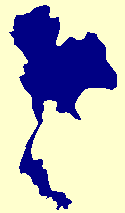
Flora of Thailand
Euphorbiaceae

 |
|
 |
Goto on this page:
Airy Shaw, Kew Bull. 19: 313. 1965; Kew Bull. 32: 408. 1978; Kew Bull. 36: 608. 1981; G.L.Webster, Ann. Missouri Bot. Gard. 81: 79.1994; Radcl.-Sm., Gen. Euphorbiacearum: 179. 2001; Welzen in Chayam. & Welzen, Fl. Thailand 8, 1: 163. 2005; G.L.Webster in Kubitzki, Fam. Gen. Vasc. Pl. 11: 136. 2014.— Sinopimelodendron Tsiang, Acta Bot. Sinica 15: 132. 1973.
Trees, monoecious. Indumentum of short stellate hairs, but mainly glabrous all over. Stipules very small. Leaves spirally arranged, simple, glabrous; petiole flat above, slightly pulvinate at base and apex, usually with 2 (indistinct) glands at apex; blade ovate to elliptic, chartaceous, symmetric, margin entire, apex acuminate to cuspidate, upper and lower surface without glands; venation raised on both sides, nerves looped and closed near margin, veins reticulately scalariform. Inflorescences racemes, each with flowers of a single sex, axillary, subterminal, densely pilose; staminate ones with groups of 1—3 flowers per node; pistillate ones with only 2 or 3 terminally developing flowers. Flowers actinomorphic, petals and disc absent. Staminate flowers sessile; calyx 4-lobed, valvate; stamens 4 or 5, free, anthers 2-celled (appearing as 4 when unripe); pistillode present. Pistillate flowers on short, stout pedicels; calyx irregularly dehiscing into lobes; single staminode seen; ovary 2-locular; ovules 1 per locule; style very long (Thailand), stigmas indistinct (Thailand). Fruits lobed and stiped drupes, chartaceous, densely pilose. Seeds ecarunculate.
Two species, one in S. China (Kwangsi/Guangxi Prov.), the other in Myanmar and W. Thailand. Classification: subfam. Acalyphoideae, tribe Epirprineae, subtribe Epiprininae.
1. Cleidiocarpon laurinum Airy Shaw, Kew Bull. 19: 313. 1965; Kew Bull. 36: 608. 1981; Welzen in Chayam. & Welzen, Fl. Thailand 8, 1: 164, fig. 36. 2005.
Trees 5 m up to tall. Stipules triangular, c. 0.6 by 0.3 mm. Leaves: petiole 1—3.7(—5) cm long; blade 7.2—15 by 2.4—5.5(—7.2) cm, length/width ratio (2—)2.7—3; nerves c. 12. Staminate inflorescences up to 7.5 cm long. Staminate flowers c.2.2 mm in diameter; calyx 2.2 mm long, lobes 1.5—1.6 by 1.3—1.5 mm; filaments c. 2.5 mm long; stamens c. 0.7 by 0.7 mm; pistillode c. 1 mm high. Pistillate flowers c. 3 mm in diameter in young fruit; pedicel in fruit up to 14 mm long, gradually thickening to up to 5 mm; calyx c. 2.5 mm high; staminode c. 1.2 mm long; style c. 11 by 1.5 mm. Fruits 20 (1 lobe developed)—35 (2 lobes developed) by 24—26 mm, stipe c. 5 mm high, 1.8—2 (when 1 lobe developed) to 2.2—2.8 (when 2 lobes developed) by 1.4—1.6 mm, venation coarsely reticulate and raised when dry. Seeds flattened subglobose, c. 19 by 18 by 14 mm.
T h a i l a n d.— NORTHERN: Nan (Doi Phu Kha National Park); CENTRAL: Saraburi (Klang Dong); SOUTH-WESTERN: Kanchanaburi (Khao Yai).
D i s t r i b u t i o n.— E. Myanmar (type) and W. and Central Thailand.
E c o l o g y.— Dry evergreen forest. Altitude: 750—1150 m.
N o t e.— Larsen 9390 from Klang Dong is tentatively added to this very ill known species. Its leaves are broader and the petiole somewhat longer (indicated between brackets in the description), while the petiolar glands are seemingly lacking. The description of the staminate flowers is based on this specimen. Airy Shaw (1981) indicates that it might represent a new species.